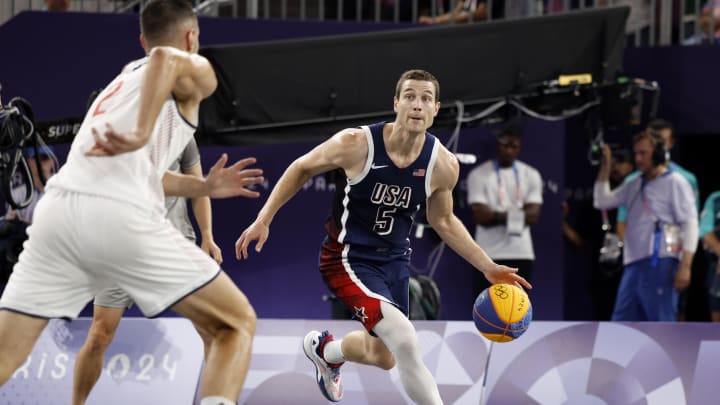SI:AM | Team USA Struggles Mightily in Olympic 3x3 Basketball

Good morning, I’m Dan Gartland. I can’t believe we’re already approaching the halfway point of the Olympics.
In today’s SI:AM:
🐐 Biles back on top
🏃♀️ Gail Devers Q&A
🥇 A big swimming gold for the U.S.
Far from a Dream Team
American basketball fans are accustomed to seeing their country dominate in the Olympics. The men’s team has won 16 of the 20 Olympic tournaments, while the women have won nine out of 12. When it comes to five-on-five hoops, there’s no one better than the United States.
But it’s a different story in the Olympics’ newest version of basketball. This is the second year that 3x3 basketball has been part of the program. The U.S. women won gold when the sport debuted in Tokyo, while the men did not qualify for the first competition. Both teams are in the field in Paris this year—and it’s not going well.
The U.S. women lost their first three games—including a shocking loss to Azerbaijan—before winning their next two to move to 2–3 in pool play. The men, meanwhile, are the only team in the tournament yet to win a game. They’re 0–4. So what’s gone wrong?
Forcing @Dan_Gartland to answer the hard questions about 3x3 basketball 🏀
— Mitch Goldich 🐙 (@mitchgoldich) August 2, 2024
Subscribe to SI’s Daily Rings podcast before it disappears in 10 days!
Apple: https://t.co/YvvWstG47k
Spotify: https://t.co/9OwWdwwnBf pic.twitter.com/xuqLGuU254
For context, 3x3 basketball is basically what it sounds like. Teams play three-on-three on a court roughly half the size of a normal court. You get two points for a shot outside the three-point line and one point for shots inside the arc. The winner is the first team to score 21 points or whoever is leading after the 10-minute clock runs out.
It’s an incredibly fast-paced game. Fewer players on the court means more space for those players to cover. You have to start playing tough defense as soon as a basket is scored, trying to make your opponent use as much of the 12-second shot clock just attempting to clear the ball outside of the arc. And with only four players on each roster, the athletes end up giving max effort for long stretches.
That sort of action makes for a great viewing experience—unless you’re a U.S. fan. Watching the American teams in these Olympics has been remarkably frustrating. The first stage of the tournament is an eight-team round robin, after which the top two teams advance automatically to the semifinals while teams three through six play a play-in game to decide the other two semifinal spots. Right now, both U.S. teams are fighting for their lives.
The women beat France, 14–13, in a hard-fought, low scoring affair in their first of two games on Friday to move into sixth place. They’ll play again later on Friday (noon ET) against Canada in a game that can either solidify their chances of advancing or put them in danger of being eliminated.
The situation is more dire for the men, who are 0–4 after blowing a late lead against Latvia in their match on Thursday night. The American men are the only winless team in either tournament and will likely need to win all three of their remaining matches and have some lucky breaks go their way if they hope to advance.
So why is the U.S. performing so poorly in the 3x3 tournament compared to the five-on-five? Well, for one thing, the sheer depth of talent the U.S. has is more of an advantage when building out a 12-player roster than a four-player roster. Countries like Azerbaijan are capable of finding four quality players who specialize in 3x3 and are able to form a world-class team. Another main factor is that many of the other teams are composed of players who specialize in 3x3. Serbia’s Dejan Majstorović, for example, has been playing 3x3 almost exclusively since 2013. Cierra Burdick of the U.S. women’s team won her first international gold medal in 3x3 in ’14, but most of the rest of the players on both U.S. rosters are newer to the game. The U.S. women’s roster includes two active WNBA players (Dearica Hamby and Rhynne Howard) and one current NCAA player (Hailey Van Lith). Playing 3x3 is just something they do on the side. The U.S. could surely perform better in 3x3 competitions if it devoted more attention to it, but Americans can at least take some solace in the country’s continued dominance of the five-on-five game.
The best of Sports Illustrated
- Here is Mitch Goldich’s guide to what to watch at the Olympics on Friday.
- Stephanie Apstein was at the women’s gymnastics all around on Thursday, where Simone Biles reclaimed her spot on top of the sport.
- Greg Bishop spoke with American sprinting legend Gail Devers about this year’s U.S. track team.
- Pat Forde wrote about Kate Douglass’s win in the 200m breaststroke, which gave the U.S. a much-need gold after a long series of silvers.
- French golfers were taken aback by the support they got from the home crowd in the opening round of the Olympic tournament, Bob Harig writes.
- Madison Williams pays tribute to Andy Murray, whose storied tennis career came to an end with his loss in the Olympic men’s doubles tournament.
- Our NFL training camp report series continues with Albert Breer on the Packers, Matt Verderame on the Chiefs and Conor Orr on the Giants.
- Mike Trout is officially out for the rest of the season after suffering another meniscus tear.
- Georgia receiver Rara Thomas was dismissed from the team after his arrest last week.
The top five…
… things I saw yesterday:
5. Andy Murray’s tweet after his final match of his career.
4. Marine Johannès’s no-look pass.
3. Bobby Witt Jr.’s homer to kick off the month of August after he batted .489 with a 1.353 OPS in July.
2. Suni Lee’s floor routine that put her in position to win bronze.
1. Simone Biles’s gold medal-clinching floor routine.
